Character Creation
by Shadowiii
Warning: Every graphic on this page is property of Shadowiii. This includes every sketch, hero graphic, NPC, or whatever else I decided to put in. If you steal this stuff and put it in your games, not only will you make me mad, but you'll look like a moron because everyone will know you ripped it from here. So don't bother.
::Contents::
Basic Story and Basic Character Concept
Create and Clothe
Initial Sketches
Final Sketches and Pixelation
NPC
Final Editing/Conclusion
Basic Story and Basic Character Concept
First off, this isn't an article on Character Development, though that was my initial plan. You won't learn how to make your character a great brooding kinda guy or a bubblingly annoying, sugar-high heroine. What this is are a few tips and steps to help you create and draw a character well. There may be a Character Development article later, but considering how long it probably would be, you'll just have to be patient. Also, in this article, I do not tell you how to draw a hero graphic pixel by pixel. Instead, I point out steps that have helped me out when drawing my heros. This system I know has worked for a lot of people, but it doesn't work for everyone. If you have a better style, by all means use it instead. If you just boot up the engine and start pixelating, you might want to consider my method.
The first thing in designing a character is to obviously get a story in order. All RPG's, be they big or small, need to have the story developed first before you continue on to actually making the game itself. The story need not be completely fleshed out on its inital run. That is, you definatly don't need all the details written out on the first push. Instead, get the basic framework of your story down, then focus on what is actually more important, the characters.
See, a story can be an epic work of Shakespeare, but if the characters are dull and shallow, the game just won't fly. So, after you have your basic framework, work extensively on the characters. What are their pasts? Do they have any plans for the future? If they are human, what are their strengths? Weaknesses? By this I don't mean "WEAKNESS FIRE AND STRENGTH ICE LOLOL", I mean what are they afraid of? What do they enjoy doing? What do they enjoy eating? How is their current life? Just like your hero can't just grab some guy off the street and expect him to join your quest, you can't just hope to pull a character from thin air complete with a detailed life.
This is very important. You need to take your character and BE him or her. Don't just make the character be another guy, make him be YOU when you are developing him. Since you created the character, you need to know every aspect of his emotions, even if you don't show ALL of them in your game. You need to understand exactly how he'll react in a situation. You need to know his preference, his hair style, where he likes to eat, his goals, his hidden secrets, EVERYTHING. In truth, you need to be this character, even if he/she is just a side character. Why? Simple enough. Too many OHR games have a main character or villian with some major development, so they throw all the side character's emotions and feelings out the window. Or, more commenly, they shove in the "generic RPG sidekick" feelings for the guy. "Hello, I'm hyper and cheerful but have some deep dark secret!" "Hello, I'm an arrogant punk, but in truth I have a heart and am a big wuss!" "Hello, I'm a dark evil looking guy who is actually a really nice guy in disguise!" "Hello, I'm a noble serious guy, who gets annoyed by the littlest things, much to the amusment of the other heroes!" Blah blah blah. Although these characters aren't all that bad, what is bad is not developing them. A good idea to help develop your character's personallity is to do mock scenarios in your head, ie, what would this character do in this situation? What would he say? How would he react? You don't even need it to be a situation in your game, it could be a common problem like "the milk is spoiled" or "I didn't look both ways before crossing the street." Every extra detail will help in the long run.
In essence, your character needs to be flesh and blood living. Only then can you really make decisions AS him (decisions such as: what he wears, his weapon of preference, his taste in women, etc.) Only after you know everything about this guy can you begin to work on his graphics and looks.
Create and Clothe
Ok, your character has been designed in your head. Now is the time to consider exactly what he looks like. First off, think to your story, and think of his background. What would he look like, and how would he dress?
For this article I am going to use two of my own examples, first Cadere Aliquis (known by me and Mr. B as "That gray guy" because we actually never gave him a name), and Stop. The first was a character design from Lacrymosa, the second from the Stop series (both projects are currently dropped). So lets take a look at both of these characters, their settings, and how we should equip them.
Cadere Aliquis lives in a world much different from our own. In it, the Ala, a race of flying beings, have enslaved the Orion and banished them to the lower-world. The Ala, who lack intelligence for technology, have relied on their superior bodily framework for superority over the Orion. The Orion, though wingless, are bright and develop various machines. The story takes place after a major war between the two where much happens that isn't relative to this character. Cadere is Ala born, and thus should be winged. However, during the war between the Ala and Orion, he turned sides, believing the Orion should not be enslaved (there is literally pages of pre-history regarding these races; you only get the quick explination). Because of this, after the Orion were defeated, his wings were severed and he was banished to the lower worlds. However, he still maintained his Ala aspects. He was fair-haired (now a light gray due to his age), and still was a bit arrogant. However, while Ala's hair turns gray as they age, they still remain fair skinned (they live exceptionally long). When designing his clothing, I took into consideration the fact that he was once noble, but now lived in a smog-filled industrial slave foundation. Thus, I decided he'd wear a red shirt (a symbol of the rich he kept after his fall), but the rest of his clothes would be gray. The exception would be his coat trim, which was red. The gray was what the common Orion wore, but the red showed he was something superior among the Orion, perhaps one with some power. His long, dark coat was to cover his severed wings, as well as fit him in with the Orion people. Guess what? He's dressed now.
As you can see, thought is required to clothe a character, or to describe them, anyway. You need to take pieces from their past, present, and future to develop them. Of course, the detail doesn't nearly need to be this picky as I did in this character. You can be relatively lazy as well take the next character for example.
Stop, on the other hand, actually had little development regarding her clothing and hair and such. Though she was a well developed heroine, her appearance didn't really matter much at all. She was a girl who lost her mind and memories and ended up at the End of Time, not knowing anything about anyone or anybody. I gave her basic clothing: jeans, tank top, shoes. She was a memoryless character, so I didn't want the player getting any hints from her clothes about her. Ok, so you are saying "Moron! She's wearing modern clothes! She's a modern girl!" But then I gave her brown gloves and a sword, in a middle ages kinda thing. This was ment to befuddle the player somewhat. Stop was a game that revolved around time travel. As you entered each age, they all had their trademark clothing and such, as well as weapons. A girl from the future had atom guns, for example, where a girl from a modern era had a chain and pistol. Because the clothing said so much about my characters, and since Stop actually came from no time at all (explained in the game), she had to not be associated by the player as part of an era. So I designed her this way. Her blue hair color was because I was out of 16 colors, and since her skirt was red and her pants were blue, as well as the fact I didn't want her red-haired, she got blue hair. Of course, this adds to the mystery, because she is the only person in all time with non-natural hair. Though I didn't think this deep into it at first, I first actually thought "dang, out of colors!" :P
Off on a tangent, I did the opposite for the supporting hero, Infinity. He comes equipped with pistols, a green coat, shirt and pants, as well as spiked hair. Though you meet him at the End of Time (thus not knowing his era of origin), his clothing gave it away that he was from our present.
Clothing, hair, all that stuff, really defines your chracter. Considering the player probably won't know much about your character when he/she first sees him, they will make assumptions about the hero by his clothing or haircolor. Even when you are developing him throughout the game, they will still rely on his image for a majority of assumptions. This is why you need to think before you just draw him.
Ok, so now, all this stuff should be in your head. So lets get drawing!
Initial Sketches
Good work so far, if you read this far: I know, it is boring. Just a bunch of text blather. Well, luckily you get some images now, drawn crapfully by me. All of them were drawn during some class or another, so they obviously aren't top notch, but they get the job done. Ok, enough about my bad drawing skills, on with the article!
Ok, so it is all in your head. Good job! Now when you visualize your chracter, he is looking awesome and ready to go off on his quest. You COULD just skip the next few steps and go directly to hero graphics, but pixelation can be a difficult medium to place stuff directly from your brain--->OHR engine. I'd recommend you nab a pad and pencil, or your school homework, or your notebook IN school, and draw some sketches of the guy. I'd personally recommend starting with a basic standing pose. It doesn't have to be beautiful, it just has to look sort of like you imagine him. Oh, and don't whine at me about "blah blah blah I can't draw" becuase I am a HORRIBLE artist who compares drawing to getting teeth pulled at a dentist, so if I can do it, anyone can do it. It doesn't have to look fantastic, it just has to be.
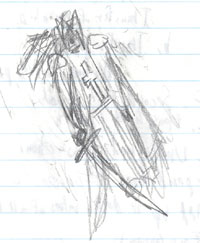
Here is my first conceptual art of Cadere. To be honest, he wasn't even completely developed yet (you can see the erased wings behind him). As you can see (if you can even understand that picture, gah its ugly), he's got the whole Sephiroth hair thing going, no face, sholder thingies, a sword, trench coat type thing, and...pants. He's also got a cross on his shirt, just to break the boredom of his regular ol' T-shirt. :P Now, you may think "Man, Shadow, that looks bloody awful. Don't tell me you used THAT as a base?" Would you belive it? My final image is almost an exact replica of this guy. Nuts huh? Lets look at Stop's original sketch.
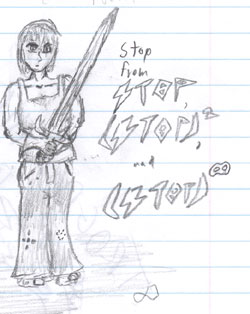
To be honest, this isn't the first sketch of Stop, it is the second, drawn about three months later. The first was drawn way before anything was developed (and I couldn't find in my messy drawers), but it looked basically the same, except the first one was kinda in the style of Final Fantasy Tactics (I really liked that pic...and now I can't find it...:'( oh well). Anyway, back on topic, you can see the basics here. She has girly pants, a top, and short hair. Though the hair went more "up" later, this sketch is a pretty good one on how she started. The fact that she had short hair was a MAJOR development, because my initial idea was long brown hair, but I decided, due to her more developed character, she needed to look more "tomboyish." She is leaning to the left (don't look too much or it will really start to bug you :P), but still, not all that bad.
These are decent examples of initial sketches. Initial sketches should take only 10-15 minutes. Don't bother jazzing them up, don't bother erasing much, just draw fast and hope for the best. If it really looks bad, instead of modifying it, draw a quick new one until you get one that is ok. The important part is that your character is now somewhere besides your forgetful mind, so whenever you forget some detail you had, you can look at this sketch and remember it.
Do a lot of sketches. I mean a lot. I mean a LOT a lot. Though it isn't really necessary to draw a lot, it helps out immensly. You can get a better feel for their details, and the more you draw them the more defined they are. Doing this really helps out in the next part.
Final Sketches and Pixelation
Finally, time to actually pixelate. By now you have a great feel for your character in an art sense. He or she is well defined, you know all the details of their dress, and you have their personalities down to a "t." You should also have their weapon of choice chosen. So now you are ready to draw the first pixelated from of this hero of great justice. But first, you need to figure out another really important thing: their fighting style.
Everyone has their own fighting style. I, personally, fight defensive and rely more on agility to inflict fatal blows then strength. A friend of mine just lunges at you and swings with full force. How your hero fights will greatly effect how his hero graphics will be drawn. Remember that all a player sees first is what you show him. If a hero appears to fight offensively but you want him to be a defensive style character, the clash will be bad.
So now, to effectively get your positions and such right, I really recommend drawing each frame stick-figure. I don't think you need a picture for this becuase you have the general idea. Think carefully about each frame and sketch each stick figure as proportional and precise as possible, because this will more then likely be your base for your hero drawing.
Ok, stick figures done? Lets actually draw this sucker. Take your first "standing" frame, and go all out. Again, you don't have to be a good drawer, but do your very best. You'll more then likely use this as a major reference when pixelating, so try to shade as best you can. Don't bother to color; you can figure that out when pixelating. Here is my hero attack sketch for Cadere:
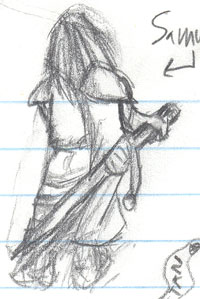
As you can see, even though this picture still isn't beautiful, it certianly gets the job done. Cadere is a defensive fighter, who stands with one sword on the hilt and the other on the scabbard. He isn't facing the player, nor is he really facing the enemy. He is viewing both out of his side vision, showing he is confident in his skills of defence. Considering Cadere was planned to be a fabled warrior, who has supurb skills but was still very humble, it seemed right for him to be in this position. The one thing I hate is he looks like he's wearing a belt aroudn his waste, when he is supossed to be wearing a trenchcoat. Eh, whatever.
No compare this sketch with Cadere's final "standing" hero graphic:

Wow, what a resemblence! It is clear to see that I used the sketch as a major base. It is also easy to see how, even though that hero sketch was my last sketch of him in that pose, he still had quite a few changes.
If you want, you can repeat this with other hero stances, though usually by the time you draw this one in you can fudge the rest. Considering most game designers just use the same graphic and modify it slightly for attacks, you probably don't have too much work to go. For Cadere, I drew a really awful death sketch as well, which was solely to see if he looked good in that style death postition.
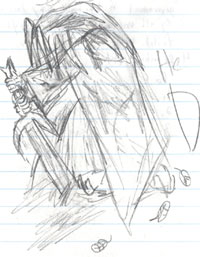
What is neat is how it resembles his drawn death graphic, even though I haven't looked at the thing since I drew it.
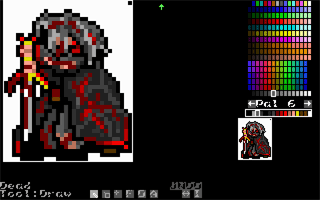
The sad story is that the original of this, which was WAY better (especially with the hair), was erased in a comp crash, but it still worked out.
If you are curious about how Stop's hero graphic turned out, here is the sketch:

Ugh, I hate her left leg so much in this picture. But remember: still a sketch, don't bother going nutso on making this perfect. Odds are the player won't even see it anyway. Anyway, this was my initial. Stop was born with a skill of fighting (which occures due to the story plot, I won't bother explaining), so in her pose she looks cool, confident, and ready to cut up some monster. I really used this as inspiration for my hero pixelated, though she doesn't look nearly as angry.
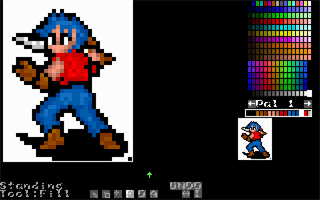
See the smiliarity? Again, I used that drawing as a major reference. Even though I still made a few changes, it still managed to work out just fine. Something interesting I noticed was my original sketches had gloves on both of her hands, while in the final pixelation she only had a left hand glove. I didn't even notice this until right now when writing this article :|. Weird...
So, in conclusion to this section, if you do nothing else, do the stick men. The stick men really help make the graphics look "realistic." If you don't use them, you are drawing off the seat of your pants and are more likely to make a sloppy mistake. After the stick men, if you think you need more detail to get your hero into the OHR, then by all means draw a sketch. But the stick men concept is by far the more important of the two. You should draw the stick men before EVERY hero graphic, even if you don't even do early sketches or hero sketches. It really helps get body actions accurately.
NPCs
I'm not going to elaborate much on this section because a full-scale NPC tutorial is in the works. But what I will say is this: use the hero graphic. USE THE HERO GRAPHIC. The hero graphic you drew should be your masterpiece, your base for all other related graphics and sketches for this guy. All your little doodles and drawings that lead up to him are unimportant now because he has been drawn. Now your main reference MUST be this hero.
When you make your NPC for whichever hero, be sure to keep the clothing and the hair the same. Though his proportions are probably going to be WAAAY different (more chibi, I'll assume), you still need to keep a few things the same. Clothing, and marks on the clothing. In my NPC for Cadere, his shirt still has that cross on it. Though his pants are basically not visible because of his "chibi-ness," his coat is still there as well as his Sephiroth style hairdo. What really makes the player attack to your guy is if you keep those little details in. It also makes the graphics much more professional, because the NPC and Hero are linked really well. Keep that in mind.

Finishing Touches/Conlcusion
Yay! You've drawn a hero graphic. So, is it done? Well, maybe, maybe not. You need to now open up the engine, draw some shoddy attacks, and test out the guy's animations. It needs to be fluid and look natural. If it doesn't work, don't just shrug it off. FIX IT. You will regret shrugging it off every time you play your game and see its cruddy animation. Testing out your graphics are very important, because what you see is what the player sees, and if what you see sucks...well, you get the picture.

(editors note, these pictures have been scaled horizontally to fit the frame, click to see full resoultion versions)
As stated at the beginning, I'm not going to tell you how to draw your hero graphics. There are many different styles, mine is only one example. Play other OHR games and study the hero graphics. Notice what you like, notice what looks bad. Try out some techniques they use when pixelating. Your style is like your signature or fingerprint: it should be completely different from everyone else's. Many OHRers can point out other game designer's games simply because of their graphical style. This is what you should strive to achieve: a unique style that is yours that is easy for you to do, and fun as well. I mean, we are here to make games and have fun doing it, right?